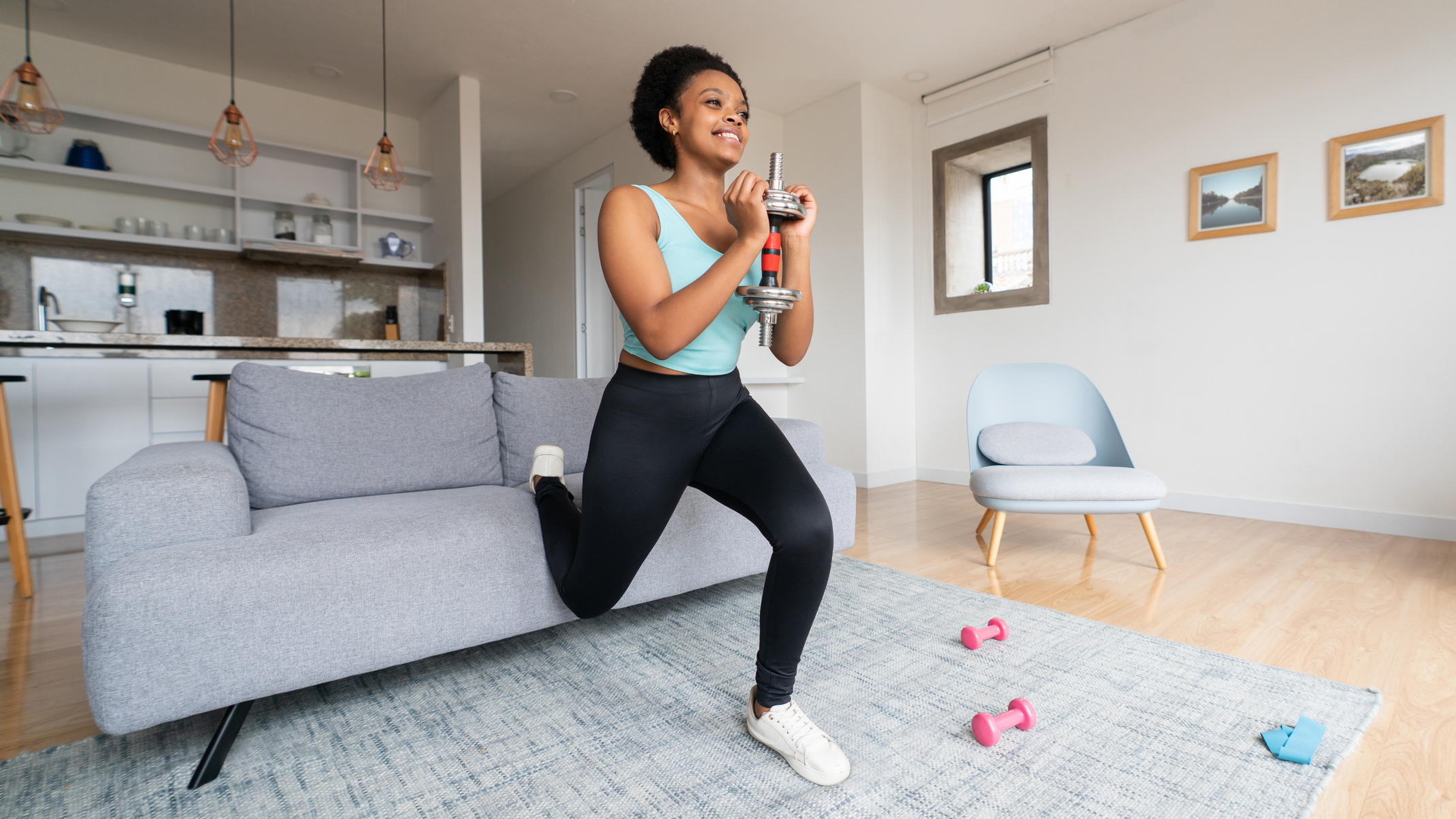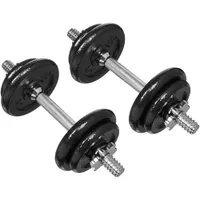Build stronger legs at home with this trainer's go-to lower-body dumbbell workout
Use supersets, slow eccentrics and isometric holds to build leg strength with just a pair of dumbbells

When you're planning to overhaul your health and fitness, it pays to start from the ground up. In other words: start with your legs.
A strong lower body will not only help form rock-solid foundations that minimize risk of injury, but because the quads, hamstrings and glutes are three of the largest muscle groups in the human body, training them will burn more calories than working just your upper body in isolation.
But where to start? I cut down on time-consuming trips to the gym since my son was born last year, so I'm always looking for home dumbbell workouts to try, and liked the look of this six-move leg session from certified trainer James Stirling, aka London Fitness Guy.
The workout includes two supersets, where two moves are completed back to back without rest, which helps save time. It targets all the major muscle groups of the lower body, including the often overlooked adductors on the inside thigh.
And all you need is a pair of dumbbells—even a relatively light pair will do—so it can be performed at home, in the gym or if you're lucky enough to be on holiday, in your hotel gym.
If you need dumbbells, now's a great time to buy with plenty of Black Friday dumbbell deals around. Along with this reliable budget pair, there are reductions on Amazon Basics's fixed-weight dumbbells and the gold-standard of adjustable dumbbells, Bowflex's SelectTech 552s.
Below I've detailed each of the moves, along with a couple of suggestions for how to make this workout work for you, no matter your ability.
How to do this home leg workout
A post shared by James Stirling - HOME WORKOUTS 💪🏻 (@london_fitness_guy)
A photo posted by on
Warm-up
To kick off Stirling recommends a simple two-move bodyweight warm-up of lunges with rotation followed by good mornings to wake up your lower-body muscles and mobilize your posterior chain. Perform 12 slow and controlled reps of each, taking extra time if you're performing this workout first thing in the morning when you're likely to be extra tight.
Start your week with achievable workout ideas, health tips and wellbeing advice in your inbox.
1A. Glute bridge
Sets: 3 Reps: 12
- Lie on the floor with your feet hip-width apart and flat on the floor.
- Hold one dumbbell across your thighs.
- Drive through your feet to lift your hips until your body is in a straight line from shoulders to knees.
- Lower slowly to the start.
Make it easier: Hold the top position of the glute bridge for a count of 12, rather than performing 12 reps.
Make it harder: Rest your upper back across a sofa or bed to increase the deficit.
1B. Tempo squat
Sets: 3 Reps: 12
- Stand with your feet shoulder-width apart, with your toes pointing out slightly.
- Rest one end of each dumbbell on your shoulders, keeping your elbows high.
- Push your hips back and bend your knees to lower slowly for a count of three.
- Drive up powerfully to stand.
Make it easier: Use one dumbbell, held upright in a goblet squat position.
Make it harder: Pause for a count of three at the bottom of each rep.
2. Bulgarian split squat
Sets: 3 Reps: 12 each side
- Holding dumbbells by your side, place the top of one foot behind you on an elevated surface, such as a sofa or bed.
- Bend your front knee to lower until your thigh is parallel to the floor.
- Drive through your front foot to stand back up.
- Complete all the reps on one side, then switch sides.
Make it easier: Use one dumbbell, holding it on the same side as your front leg.
Make it harder: Pause for a count of three at the bottom of each rep.
3. Stiff-leg deadlift
Sets: 3 Reps: 12
- Stand with your feet hip-width apart and a very slight bend in your knees.
- Engage your core and, keeping your back flat throughout, push your hips back to lower the weights to shin height.
- Drive your hips forward to stand back up.
Make it easier: Use one dumbbell, held upright in both hands.
Make it harder: Switch to single-leg deadlifts for an added balance test.
4A. Lateral lunge
Sets: 3 Reps: 12 reps each side
- Stand holding dumbbells by your sides.
- Step your right foot out to the side, and bend your right knee and push your hips back to lower the weights to either side of your right foot. Keep your chest facing forward.
- Only lower as far as you can comfortably, then drive up to return to the start.
Make it easier: Perform without dumbbells.
Make it harder: Rack the weights at shoulder height for an added core challenge.
4B. Bear to plank
Sets: 3 Reps: 12 reps
- Start on your hands and knees, then lift your knees just off the floor.
- Step one foot back, then the other to assume a straight-arm plank position with your body in a straight line from head to heels.
- Step one foot forward, then the other to return to the start position.
- Move slowly and with control to keep your hips locked in place.
Make it easier: Hold a standard plank on your forearms for a count of 20-30 seconds.
Make it harder: Switch to a bear crawl, moving forward and back with knees just off the floor.

With a warm-up and quick stretch after, I can rattle through this workout in around 30 minutes, so I can fit it in easily before my commute or in my lunch break when working from home.
I put the dumbbells to one side when I do the lateral squat. The adductors are chronically underworked for most people, me very much included, and I find this exercise is as much about improving flexibility of the inner thigh muscles as it is building strength.
With the rest of the exercises, I like to mix up the tempo with two slow eccentric sets to increase time under tension and build muscle, then one slightly faster set to finish to develop greater strength endurance. That way this workout always feels fresh and provides a new stimulus that keeps me coming back for more.

Sam Rider is an experienced freelance journalist, specialising in health, fitness and wellness. He is also a REPS level 3 qualified personal trainer.

